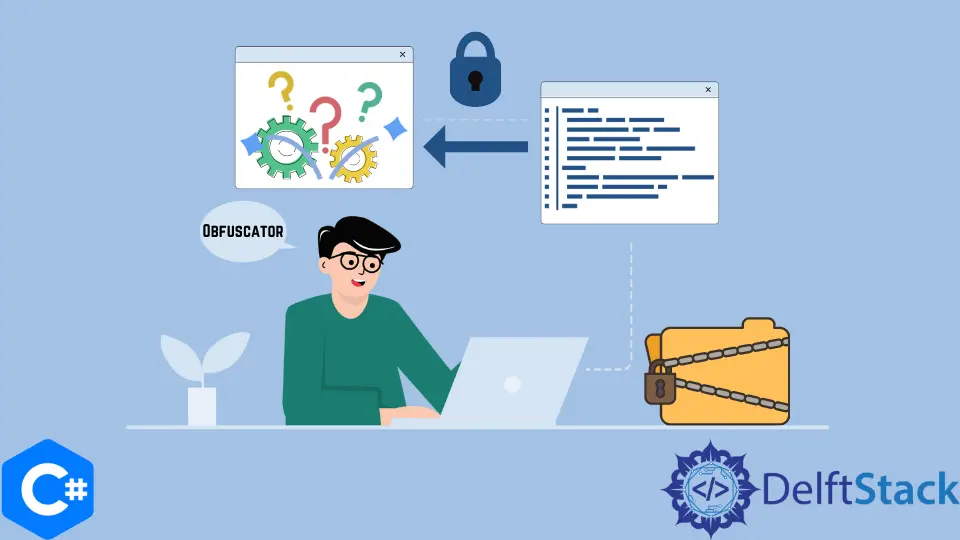How to Obfuscate Your Code in C#
-
What Code Obfuscation Means in
C# -
Code Obfuscation in
C# -
Approaches to Implement Obfuscation in
C#Using These Tools -
Rename Obfuscation in
C# -
String Encryption in
C# -
Anti-Debug of Code in
C# -
Anti-Tamper of Code in
C# -
Dummy Code Insertion in
C# -
Binary Linking/Merging in
C#

This article will introduce you to how you can obfuscate your code in C#. Using a variety of ways and some tools that can aid in the process.
Most non .Net compilers emit binary programs that contain native CPU instructions. Which are very difficult to disassemble, decompile and reverse engineer.
However, all .Net compilers like C# and Managed C++ deliver programs compiled in MSIL (Microsoft Intermediate Language Format).
This format retains a lot of high-level information on your software, such as class names, fields, methods, property, and settings, as well as even the actual code in a rich structure.
As a result, different decompilers and disassemblers have been created to extract this information from a .Net assembly.
What Code Obfuscation Means in C#
The technique of modifying an executable to be no longer useful to a hacker but remains fully functional is known as Code Obfuscation.
Although the procedure may modify method statements or metadata, it does not affect program output.
Code Obfuscation in C#
Code Obfuscation comprises several diverse approaches that work together to provide a layered defense. It’s especially useful for languages like C# that emit intermediate-level instructions.
There are several Obfuscator tools available that can assist you in making your C# code difficult to interpret by hackers.
- .NET Reactor
- Eazfuscator.NET
- Babel
- ConfuserEx
Approaches to Implement Obfuscation in C# Using These Tools
There are several approaches to make your code not-understandable to anyone. A couple of them are discussed in the following paragraphs.
Rename Obfuscation in C#
This technique modifies the names of methods and variables. It makes the decompiled source difficult to comprehend for humans but does not affect program execution.
The new names may employ various schemes such as alphabets, digits, and unprintable or invisible letters.
As long as the scopes of the names differ, they can be overloaded. Most C# Obfuscators employ the name obfuscation as a fundamental transformation.
Original Source Code Before Rename Obfuscation:
public class Data {
public int age;
public Data(int age) {
this.age = age;
}
}
Source Code with Rename Obfuscation Implemented.
public class a {
public int b;
public a(int b) {
this.b = b;
}
}
String Encryption in C#
Strings are immediately identifiable as part of well-managed, well-executed code.
Even if methods and variables are renamed, string references can find important code areas by checking for string references within the binary.
This contains any messages that the user can view. It will provide a barrier against this form of attack.
String encryption encrypts strings in the executable but only returns their actual value when needed.
Original Source Code Before String Encryption:
Console.WriteLine("Encrypt this");
Source Code with String Encryption Implemented.
Console.WriteLine("x%$&#@");
Anti-Debug of Code in C#
When an attacker tries to change your data or steal the functionality of a critical component, they’ll probably start with reverse engineering and debugging.
Professionals and hackers use tools to analyze code line by line. An obfuscator can identify it via application self-protection.
When a debugger is used, it can destroy crucial data, trigger random crashes, or do any particular action.
IT security professionals can use Anti-debug tools to detect whether a hacker uses a debug application as part of an attack.
Hackers can utilize anti-debug tools to identify when a debug tool is used to determine the changes they’re applying to the code.
Anti-Tamper of Code in C#
An obfuscator can inject application self-protection into it. If tampering is discovered, the program can be shut down, its functionality limited, random crashes (to hide the cause of the crash), or any other specific action taken.
It may also send a message to a service informing it of the discovered tampering.
Dummy Code Insertion in C#
Insert code into an executable that has no influence on the logic of the program but breaks decompilers or makes reverse-engineered code far more difficult to understand.
Binary Linking/Merging in C#
This transform combines several input executables/libraries into one or more output binaries.
Linking can help you minimize the size of your application, especially when combined with renaming and trimming.
It can also make deployment easier and minimize the number of information hackers have access to.
I'm a Flutter application developer with 1 year of professional experience in the field. I've created applications for both, android and iOS using AWS and Firebase, as the backend. I've written articles relating to the theoretical and problem-solving aspects of C, C++, and C#. I'm currently enrolled in an undergraduate program for Information Technology.
LinkedIn